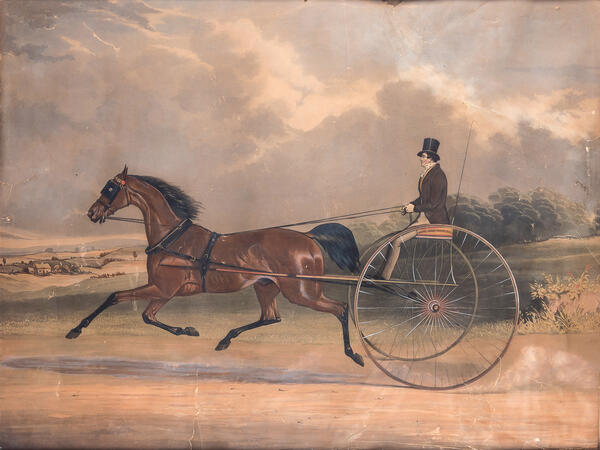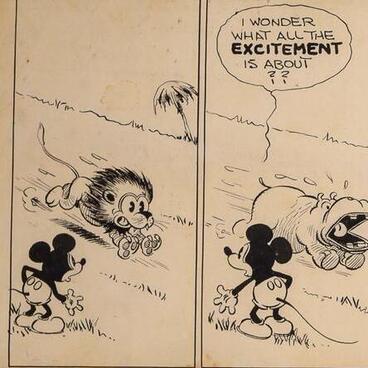The Film Museum displays an engraved reproduction made by an English artist James R. Mackrell from a painting by William Joseph Shayer. It was probably hung at Sergei Eisenstein’s summer house in KrAtovo. As legend has it, such an engraving was in the apartment of MikhaIl Eisenstein, the director’s father, in RIga, and Sergei Eisenstein probably bought this hand-painted copy in memory of his father’s house.
Lord William was the name of a champion record horse, which (as the inscription says) crossed the distance from London to Brighton in 3 hours and 50 minutes in 1842. The painting portrays an English lord riding a race horse harnessed to a cart, but the artist entitled the painting by the name of the horse, not its owner.
In his memoirs, Sergei Eisenstein wrote that his father loved horses and it was for the horse routines that he often went to the circus, where he also took little Rorik (Eisenstein’s nickname as a child). Seeking to join the nobility, MikhaIl Eisenstein believed it was important for himself and his son to master the horse-riding. ‘Daddy used to ride, ’ the director wrote. ‘He was a stodgy man and only one horse from Riga’s Tattersal, the giant Peak with a bluish half-belly on one eye, could hold him. I was also trained to ride. (…) I failed to become a cavalryman. After the well-known mad horse Zaychik carried me in full gallop along the Riga coast (…), — [I] somehow lost interest in riding.’
However, the riding skills still came in handy for Eisenstein. In 1919, during the Civil War, he served as a military civil engineer and designed the trenches near Vologda against the likely attack of British troops landing in Arkhangelsk. He had to ride around the fields on a combat horse, which was the main means of transportation back then. In 1930, while seeking impressions looking for the scenes for possible productions in the United States (however, Hollywood producers did not let him carry out any plans), Sergei Eisenstein visited the state of Arizona and had a firm seat in the saddle when the conductors, Navajo Indians, offered him to ride a horse. In Mexico, however, the same incident as with Zaychik occurred. The director wrote in his memoirs: “…Next time I was ruthlessly carried by a Mexican horse through the maguey plantations around the Tetlapayac hacienda. From then on, I ride only cars.”
Lord William was the name of a champion record horse, which (as the inscription says) crossed the distance from London to Brighton in 3 hours and 50 minutes in 1842. The painting portrays an English lord riding a race horse harnessed to a cart, but the artist entitled the painting by the name of the horse, not its owner.
In his memoirs, Sergei Eisenstein wrote that his father loved horses and it was for the horse routines that he often went to the circus, where he also took little Rorik (Eisenstein’s nickname as a child). Seeking to join the nobility, MikhaIl Eisenstein believed it was important for himself and his son to master the horse-riding. ‘Daddy used to ride, ’ the director wrote. ‘He was a stodgy man and only one horse from Riga’s Tattersal, the giant Peak with a bluish half-belly on one eye, could hold him. I was also trained to ride. (…) I failed to become a cavalryman. After the well-known mad horse Zaychik carried me in full gallop along the Riga coast (…), — [I] somehow lost interest in riding.’
However, the riding skills still came in handy for Eisenstein. In 1919, during the Civil War, he served as a military civil engineer and designed the trenches near Vologda against the likely attack of British troops landing in Arkhangelsk. He had to ride around the fields on a combat horse, which was the main means of transportation back then. In 1930, while seeking impressions looking for the scenes for possible productions in the United States (however, Hollywood producers did not let him carry out any plans), Sergei Eisenstein visited the state of Arizona and had a firm seat in the saddle when the conductors, Navajo Indians, offered him to ride a horse. In Mexico, however, the same incident as with Zaychik occurred. The director wrote in his memoirs: “…Next time I was ruthlessly carried by a Mexican horse through the maguey plantations around the Tetlapayac hacienda. From then on, I ride only cars.”



